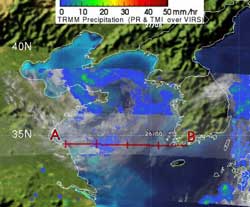NASA sees Tropical Depression Meari about to cross North Vietnam

TRMM saw Tropical Depression Meari on June 26 at 1210 UTC (8:10 a.m. EDT) as it neared landfall in North Korea. The yellow and green areas indicate moderate rainfall between .78 to 1.57 inches per hour. There were no red areas seen from TRMM, which usually indicate heavy rainfall. Credit: NASA/SSAI, Hal Pierce<br>
TRMM captured an image of the rainfall in Tropical Depression Meari on June 26 at 1210 UTC (8:10 a.m. EDT). Most of the rainfall was light to moderate in the system, with the heaviest rain near the center of circulation falling at a rate between .78 to 1.57 inches (20 and 40 mm) per hour.
Satellite imagery showed that Meari had become more elongated (because of wind shear) which indicates that the storm is weakening. Between the elongation of the system and the weak convection (lighter rainfall), Meari has lost much of its energy.
On June 27 at 0000 UTC (June 26 at 8 p.m. EDT), the Joint Typhoon Warning Center issued their last advisory on the system. At that time it was about 115 nautical miles west- Northwest of Seoul, South Korea, near 38.3 North latitude and 124.7 East longitude. It was moving to the northeast at 11 knots (13 mph/20 kmh).
The increased wind shear and cooler sea surface temperatures where Meari is now located have taken the steam out of the system. It is expected to fall apart as it crosses over the rough landscape of the Hamgyeong Mountain Range. The remnants of this system may track through North Korea and enter the Sea of Japan. It will be watched for possible regeneration at that time.
Media Contact
More Information:
http://www.nasa.govAll latest news from the category: Earth Sciences
Earth Sciences (also referred to as Geosciences), which deals with basic issues surrounding our planet, plays a vital role in the area of energy and raw materials supply.
Earth Sciences comprises subjects such as geology, geography, geological informatics, paleontology, mineralogy, petrography, crystallography, geophysics, geodesy, glaciology, cartography, photogrammetry, meteorology and seismology, early-warning systems, earthquake research and polar research.
Newest articles

“Nanostitches” enable lighter and tougher composite materials
In research that may lead to next-generation airplanes and spacecraft, MIT engineers used carbon nanotubes to prevent cracking in multilayered composites. To save on fuel and reduce aircraft emissions, engineers…

Trash to treasure
Researchers turn metal waste into catalyst for hydrogen. Scientists have found a way to transform metal waste into a highly efficient catalyst to make hydrogen from water, a discovery that…

Real-time detection of infectious disease viruses
… by searching for molecular fingerprinting. A research team consisting of Professor Kyoung-Duck Park and Taeyoung Moon and Huitae Joo, PhD candidates, from the Department of Physics at Pohang University…




















